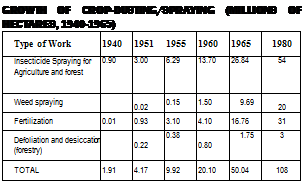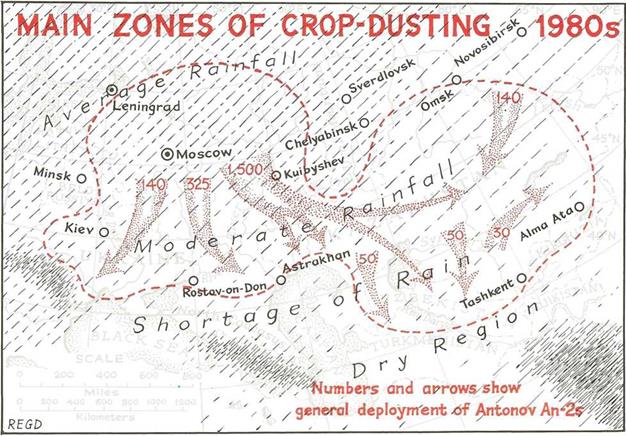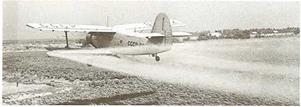Seventy Years of Aviation Aid to Agriculture


Making the Case
Certain entomologists realized the possible applications of aircraft as aids to agriculture very early in the history of powered flight; B. Rosinski, as early as 1913; N. Yatsky, in 1919; and N. N. Bogdanov-Katkov, in 1921. Also, in 1921, N. D. Fedotov suggested the use of aircraft for crop-spraying with insecticide. In 1922, a group of pilots presented a paper to the National Colegium of Agriculture of the R. S.F. S.R., and with the help of Professor V. F. Boldyrev, a special commission was formed to study the subject and to carry out experiments. During the summer, 32 experimental flights were made, in which 4.5 hectares were treated per flying hour, and these experiments continued during the next two years.
The techniques were put to the test in 1925. Under P. A. Sviridyenko’s direction, aircraft were sent to combat a plague of locusts in the flood plains of the Kuma River, in the northern Caucasus region, and during the next four years, similar operations were carried out in Daghestan, Tadjikistan, Kazakhstan, the Ukraine, and other districts in European Russia; and even as far off as Lake Baikal. A total of 111,000 hectares was treated.
Getting Under Way
In 1930, the wholesale practical application of aviation to agriculture began. An all-Soviet joint-stock company was formed, with a fleet of eleven Polikarpov U-2 aircraft; and
60,0 hectares were worked during that year. In 1931, the fleet had increased to 65 and the work in corresponding measure. Authority passed, in 1932, to Vsesoyuznyi Naychno – Issledovatyelskiy Institut Selskokhozyastvennoy I Lecnoy Aviatsiy (NIISKHA) (the All-Soviet Scientific Research Institute for Farming and Forestry Aviation,
which set up branches in Chimkent, Krasnodar, and Leningrad. Finally, in 1934, the responsibility for agriculture aviation passed to the Civil Aviation Fleet Aeroflot), and during the next few years activity grew until by 1940, almost a million hectares were covered by agricultural aircraft.
Post-War Expansion
As shown in the table on this page, aircraft were deployed widely after the end of the Second World War for agricultural work. The workload increased from 4 to 50 million hectares in the 15 years from 1951 to 1965. It doubled again during the next 15 years, reaching a peak of 108 million hectares in 1980. Nevertheless, during the next five-Year Plan, 463 mil
lion hectares were covered, or 40 percent of the total agricultural work. Of this, about 40 percent was in Russia, 20 percent in Kazakhstan, 18 percent in the Ukraine, and 15 percent in North Caucasus.
|
|











